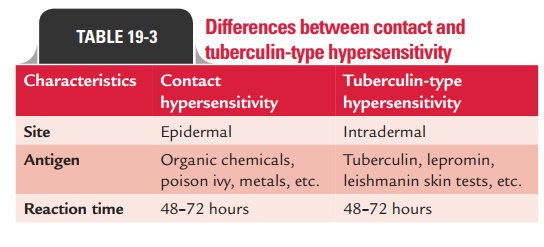Chapter: Microbiology and Immunology: Hypersensitivity
Types of DTH(delayed type hyper-sensitivity) Reactions
Types of DTH Reactions
DTH reactions are of two types: contact hypersensitivity and tuberculin-type hypersensitivity reactions.
◗ Contact hypersensitivity
Contact hypersensitivity is a manifestation of DTH occur-ring after sensitization with certain substances. These include drugs, such as sulfonamides and neomycin; plant products, such as poison ivy and poison oak; chemicals, such as formaldehyde and nickel; and cosmetics, soaps and other substances.
This reaction manifests when these substances acting as haptens enter the skin and combine with body proteins to become complete antigens to which a person becomes sensi-tized. On second exposure to the same antigen, the immune system responds by attack of cytotoxic T cells that cause dam-age, mostly in the skin.
The condition manifests as itching, erythema, vesicle, eczema, or necrosis of skin within 12–48 hours of the second exposure.
◗ Tuberculin-type hypersensitivity reaction
Tuberculin reaction is a typical example of delayed hypersen-sitivity to antigens of microorganisms, which is being used for diagnosis of the disease.
Tuberculin skin test: This test is carried out to deter-mine whether an individual has been exposed previously to Mycobacterium tuberculosis or not. In this test, a small amountof tuberculin (PPD), a protein derived from the cell wall of M. tuberculosis, is injected intradermally. Development of ared, slightly swollen, firm lesion at the site of injection after 48–72 hours indicates a positive test. A positive test indicates that the person has been infected with the bacteria but does not confirm the presence of the disease, tuberculosis. However, if a person with a tuberculin-negative skin test becomes positive, then it indicates that the patient has been recently infected. The skin test, however, can even become negative in:
· Infected persons receiving therapy with immunosuppressive drugs (such as corticosteroids and anticancer drugs) and
· In those suffering from the diseases associated with sup-pressed cell-mediated immunity (such as AIDS, sarcoidosis, lymphoma, post measles vaccination, etc.).
The response to M. tuberculosis illustrates that while on one hand mechanisms involved in DTH are required for defense against the organism; on the other hand, these are also responsible for tissue damage in the longer run. Cytokines (like TNF and IFN-g), which have been produced to activate the macrophages and thus contain the infection, also trigger other cascades that lead finally to extensive tissue damage.
Various other skin tests are used to detect DTH. These include many skin tests in bacterial, fungal, viral, and helmin-thic infections.
Lepromin test is a useful test for leprosy. A positive lepromin test indicates the presence of tuberculoid leprosy with intact

Positive skin tests in coccidioidomycosis, paracoccidioido-mycosis and other fungal infections suggest exposure to the fungi. In both viral and parasitic infections, skin tests are less specific and less useful than the serological tests for diagnosis.
Related Topics